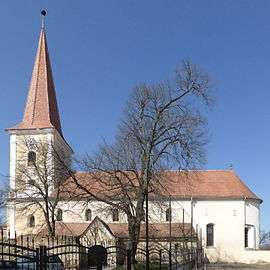Battle of Sellenberk (1916)
The Battle of Sellenberk was a World War I military engagement between Romanian forces on one side and Austro-Hungarian forces on the other side. It was part of the wider Battle of Transylvania and resulted in a Romanian victory.
Background
On 27 August 1916, Romania declared war on Austria-Hungary and proceeded to invade the Hungarian region of Transylvania. The Romanian campaign plan called for the Olt-Lotru Group of the Romanian 1st Army (General Ioan Culcer) to secure the basin between Nagytalmács (Tălmaciu/Talmesch) and Nagyszeben (Sibiu/Hermannstadt). The area between Nagyszeben and the northern exit of the Red Tower Pass was the designated assembly area for the 1st Army's Olt-Lotru Group. Opposing the Romanian invasion of Transylvania was the Austro-Hungarian 1st Army (General Arthur Arz von Straussenburg).[1] Nagyszeben (Sibiu/Hermannstadt) was occupied on 2 September by advanced troops of the Romanian 1st Army. However, the Romanians evacuated the city on the following day.[2] Erich Ludendorff referred to this in his memoirs, stating that, after taking Brassó (Brașov/Kronstadt) on 29 August, "Rumanian patrols were soon seen in Hermannstadt.".[3] The Romanians were plainly apprehensive that, in order to keep Nagyszeben under occupation, they would have to extend their bridgehead-like formation beyond capacity.[4]
The Romanian forces in the region consisted of the 1st Army's Olt-Lotru Group (2 divisions), which was placed by General Culcer under the command of General Constantin Manolescu. Opposing the Romanians was the 51st Honvéd Division (General Béla Tanárky) of the Austro-Hungarian 1st Army.[5][6]
Battle
The battle for Sellenberk (Șelimbăr/Schellenberg) started on 7 September.[7] However, on 8 September, following the German-Bulgarian victory at Turtucaia in the Dobruja, the Romanian High Command ordered a halt to the Transylvania offensive.[8][9] Nevertheless, the battle was resumed on 10 September.[10] That same day, the Romanian 1st Army entered Sellenberk.[11][12]
Aftermath
On 10 September, the Romanian 1st Army captured Sellenberk (Șelimbăr/Schellenberg), two miles southeast of Nagyszeben. This marked the end of the Romanian advance in the area for the ensuing fortnight.[13][14] Sellenberk - where Michael the Brave had defeated the Hungarians in 1599 - became the center of the main Romanian position north of the Red Tower Pass.[15][16]
References
- Michael B. Barrett, Indiana University Press, 2013, Prelude to Blitzkrieg: The 1916 Austro-German Campaign in Romania, pp. 1-2, 4, 11 and 21-22
- Cornélis De Witt Willcox, Edwin Roy Stuart, Cumulative Digest Corporation, 1918, International Military Digest Annual for 1917, p. 253
- Erich Ludendorff, Harper & brothers, 1919, Ludendorff's own story, Volume 1, p. 293
- Encyclopædia britannica Company, Limited, 1922, The Encyclopædia Britannica: The New Volumes, Constituting, in Combination with the Twenty-nine Volumes of the Eleventh Edition, the Twelfth Edition of that Work, and Also Supplying a New, Distinctive, and Independent Library of Reference Dealing with Events and Developments of the Period 1910 to 1921 Inclusive. The First-third of the New Volumes, Volume 30, p. 915
- Michael B. Barrett, Indiana University Press, 2013, Prelude to Blitzkrieg: The 1916 Austro-German Campaign in Romania, pp. 23-24 and 103-104
- Austria. Bundesministerium für Landesverteidigung, Verlag der Militärwissenschaftlichen Mitteilungen, 1930, Öesterreich-Ungarns letzter Krieg, 1914-1918, p. 92
- Austria. Bundesministerium für Landesverteidigung, Verlag der Militärwissenschaftlichen Mitteilungen, 1930, Öesterreich-Ungarns letzter Krieg, 1914-1918, p. 92
- Keith Hitchins, Clarendon Press, 1994, Rumania 1866-1947, p. 263
- Jeremy Black, Bloomsbury Publishing, Mar 17, 2011, The Great War and the Making of the Modern World, p. 107
- Austria. Bundesministerium für Landesverteidigung, Verlag der Militärwissenschaftlichen Mitteilungen, 1930, Öesterreich-Ungarns letzter Krieg, 1914-1918, p. 92
- The Times, 1917, The Times History and Encyclopaedia of the War, Volume 11, pp. 211-213
- William Dunseath Eaton, Harry C. Read, Leonard Wood, C. Thomas Company, 1919, A Complete History of the World War: A Connected and Complete Narrative of the War on All Fronts, Covering All Events Between 1914 and 1924, Volume 1, p. 394
- The Times, 1917, The Times History and Encyclopaedia of the War, Volume 11, pp. 211-213
- William Dunseath Eaton, Harry C. Read, Leonard Wood, C. Thomas Company, 1919, A Complete History of the World War: A Connected and Complete Narrative of the War on All Fronts, Covering All Events Between 1914 and 1924, Volume 1, p. 394
- The Times, 1917, The Times History and Encyclopaedia of the War, Volume 11, p. 226
- Charles Upson Clark, Dodd, Mead, 1932, United Roumania, p. 143
